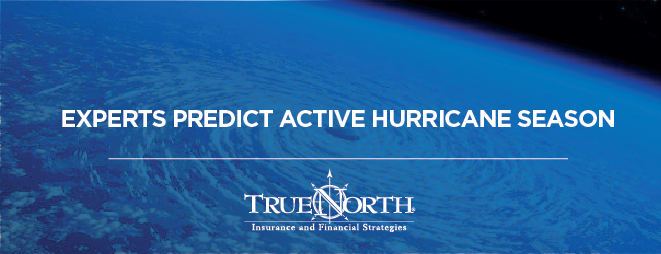Hurricane Season
posted by TrueNorth Risk Management on Monday, May 9, 2022

For 2022, Colorado State University (CSU) hurricane researchers are predicting yet another above-average Atlantic hurricane season, which runs from June 1 to Nov. 30.
In particular, CSU researchers believe there will be 19 named storms throughout 2022. This total sits above the average of 14.4 named storms per year recorded between 1981 and 2020.
Of the predicted 19 named storms, nine are expected to become hurricanes. Furthermore, four of those hurricanes have the potential to reach major hurricane strength with sustained winds of 111 mph or more. CSU researchers’ predictions are based on statistical models that use nearly 40 years of historical hurricane season data and evaluate conditions such as Atlantic sea surface temperatures, sea level pressures and vertical wind shear levels.
These predictions also highlight the likelihood of hurricanes making landfall, breaking down probabilities by region. Specifically, there is a 71% chance of a Category 3, 4 or 5 hurricane making landfall across the entire coastline of the United States during 2022—a likelihood that is 20% greater than the average over the past century. Looking at different coastlines, there is a 47% chance of this type of hurricane striking the East Coast, while there is a 46% probability of such a storm hitting the Gulf Coast.
It’s important to note that these are simply predictions. Still, individuals should make it a priority to properly prepare for severe storms, particularly if they live in or own property in hurricane-prone areas. Some key hurricane preparedness tips to consider include:
-
Assess specific risks. Individuals should make sure they know their hurricane exposures. The particular location of a home can determine wind and flood hazards.
-
Have a plan. Establishing a hurricane response plan practicing it regularly is vital. This plan should take note of possible evacuation routes and nearby emergency shelters.
-
Create a kit. Individuals should also keep a hurricane kit fully stocked with proper supplies. This includes nonperishable food, water, medicine, emergency power sources, a first-aid kit and important documents.
-
Make home adjustments. To minimize possible damages, it’s best for individuals to clear their yards of any items that could get blown around during a hurricane, as well as protect their windows and doors by installing storm shutters. Vehicles should also be stored in safe and secure locations.
-
Maintain coverage. Lastly, individuals should review their homeowners policies with trusted insurance professionals to ensure sufficient coverage in the event of a hurricane.
For additional storm safety resources - click here.
For additional risk management resources, contact TrueNorth today.
This publication has been prepared by TrueNorth Companies, L.C. and is intended for informational purposes only. Transmission of this publication is not intended to create, and receipt does not constitute, a client relationship with TrueNorth Companies, L.C. This publication does not constitute any type of representation or warranty, and does not constitute, and should not be relied upon as, legal advice. This publication is not a contract and does not amend, modify or change any insurance policy you may have with an insurance carrier. © 2022 TrueNorth Companies, L.C. All rights reserved.
About Author
In addition to helpful weekly guidance on home and auto, TrueNorth provides a number of insurance options to protect your family from risk. For information on a home or auto quote, visit www.iTrueNorth.com or call us at (319) 739-1277. We'd like nothing more than to help safeguard the things that matter most to you.
Obtain a quote on home or auto
Learn more about TrueNorth Risk Management
... read more about author